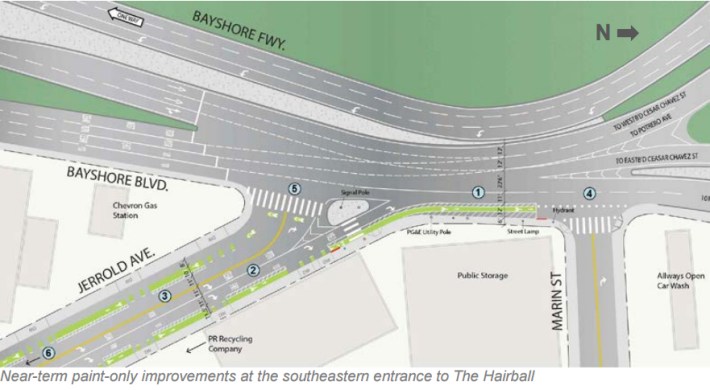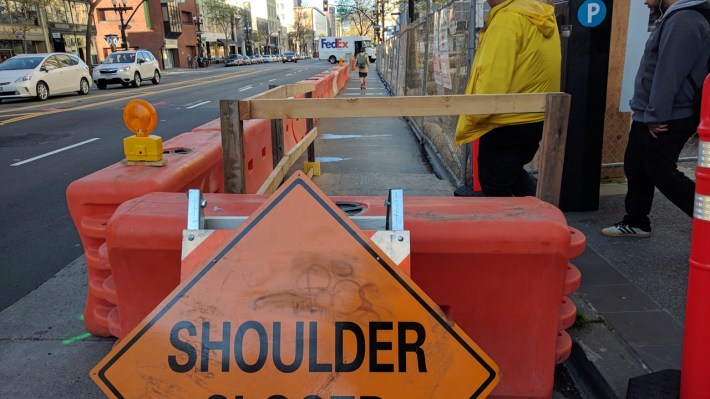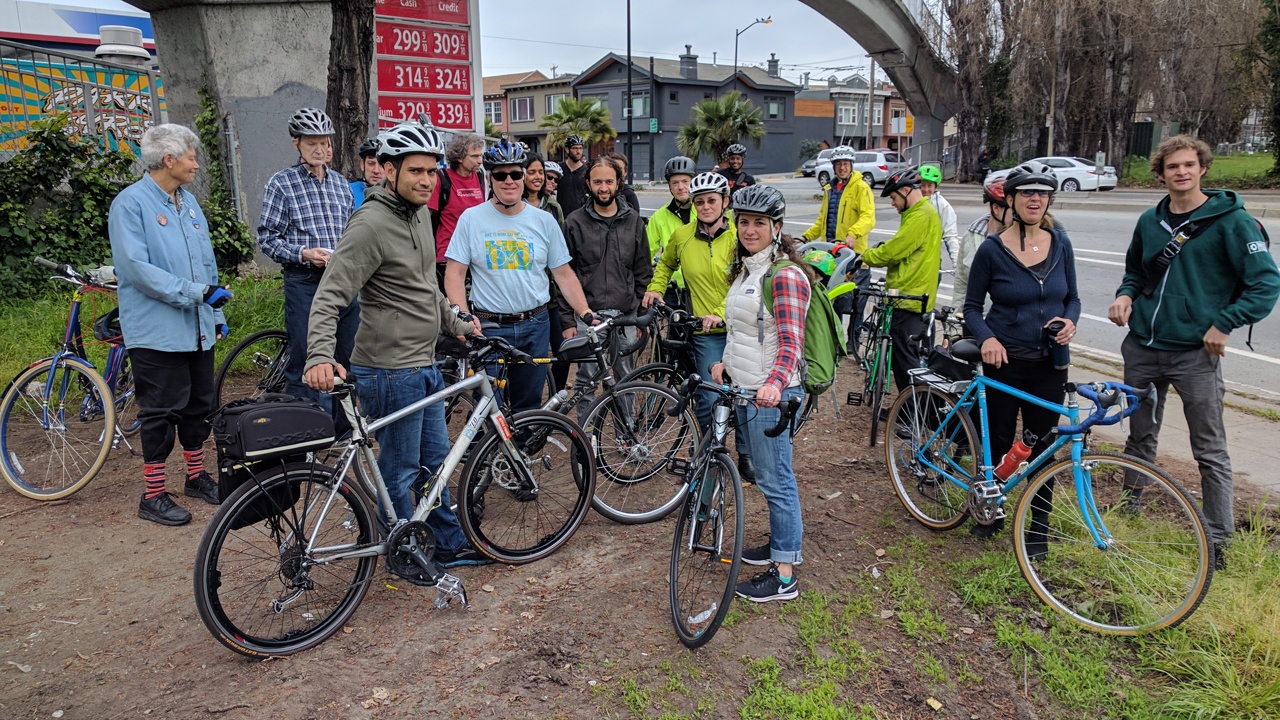Some 20 bicycle advocates and city officials met up on Saturday morning to share ideas for fixing the eastbound bike lanes of the Hairball, San Francisco's notorious maze of freeway ramps, bike lanes, and homeless camps where Cesar Chavez crosses under US-101. "There will be ten rides to understand the Hairball" and what can be done to improve it, explained Charles Deffarges, who organized the ride for the San Francisco Bicycle Coalition. "This is ride number one."
As Streetsblog readers are surely aware, the Hairball has been a problem area, both for cyclists and the homeless, who camp under the relative shelter of the overpasses. "The first thing I would fix is the homeless situation," said Chris Waddling, a cycling advocate. "Get them a place to live."
The group met at the patch of grass just east of the Allstars Gas station, where the eastbound bike path begins. Tyra Fennell, Executive Director of Imprint City, an arts non-profit, wants to see more safety lighting. Peter Khoury, who commutes from the Caltrain station via the Hairball, is also concerned about the homeless. He said bike commuters were co-existing with the camps, until they grew to the point that they were blocking the whole bike lane. "Somebody put a tarp fully across the lane," he said.
The group, which included representatives from the San Francisco Municipal Transportation Agency's Sustainable Streets division, the Department of Public Works, and homeless services, rode east through the Hairball, but got split up a bit at the signalized crosswalk where the east-bound bike path crosses the roadway ramp to Potrero and Cesar Chavez. The timing of the light is too short for the group to get across and cars kept stopping on the crosswalk. When cars weren't stopped directly on the crosswalk, they were, without exception, all well past the white-striped stop line. The reason for this was obvious--bad engineering. The traffic signal should be before the crossing, instead of after it, so that cars aren't tempted to overshoot the stop line. This kind of design, where the traffic signals are placed well beyond the point where cars are supposed to stop, encourages conflicts and needs re-thought (more on this in a future post).
The group re-assembled and crowded together on the sidewalk at the intersection of Marin and Bayshore Boulevard, where pedestrians and cyclists have to share the space. Thalia Leng, SF Municipal Transportation Agency, tried to explain SFMTA's Sustainable Streets division's plans for that corner, but it was hard to hear over the roar of the traffic. "The plan divides the hairball into segments, prioritized for safety," she said. "Near term there will be paint only, this summer, with striped bike lanes on Jerrold, curbside. On the southbound-side it will be adjacent to the parking."

Later she added that safe-hit posts would be added where possible to prevent cars from driving on and/or blocking the lane. She said, however, that the plan is to use more robust safe-hit posts than are currently used. The SFMTA will also add continental crosswalks, and greenback sharrows. Eventually, she said, in another year, more substantive dividers would be added.
One thing that was hard to miss during the meeting--the breakneck speed (and noise) of the traffic. From Streetsblog's perspective, this is no place for paint and safe hit posts, even as a short term answer. For the on-street approaches to the Hairball, SFMTA should be dropping in temporary crash barriers, such as the type used to protect pedestrians and workers during construction, as seen in the picture below. There's no reason transit agencies can't use these orange crash barriers, or something like them, to create truly protected bike lanes at locations with heavy, fast-moving traffic.

Leng also pointed to new way-finding signs to help cyclists navigate the confusing paths of the Hairball. However, they were too small and placed a bit high for cyclists. The signs are actually well above the eye-line of Andy Thornley, who stands over six feet, as seen in the photo below-right.
Meanwhile, the group collectively decided it was too noisy and oppressive to remain where they were, so they headed back west to the relatively quiet spot of dirt where they had started the tour. Once there, David Froehlich with the SF Department of Public Works, talked about plans to improve the gradient of the bike path. As Hairball users are no doubt aware, there's a point where the bike path dips down very sharply to clear one of the roadways. They will also widen the path and add more lighting. "I ride it every day," said Froehlich. "And I [call] 311 about the lights, but people tamper with them to charge their phones." One of the advocates suggested they add some electrical sockets so the homeless can charge phones without cutting into wiring from the lighting fixtures.
Froehlich also said they will replace the chain-link fence that separates the path from the grassy areas with a more robust, iron fence.
But as Streetsblog readers will recall from past articles, one of the reasons the bike path is blocked by encampments is because Caltrans chases the homeless off the grassy areas under the ramps. They then get chased back onto the grassy areas when the bike paths are cleared. "Improving" the fencing seems at cross-purposes with encouraging the encampments not to block the bike paths. Rather than protecting the bike paths from encampments, they may give the homeless nowhere else to set up camp but the bike paths.
Emily Cohen, with the SF Department of Homelessness and Supportive Housing, said the correct approach is to "work with people in the camps so they have somewhere to go." But Streetsblog and others pointed out that until enough public housing can be found, it seems cruel to make it so hard to get under the freeways during bad rains. Cohen said there are over 80 known encampments in San Francisco. The city is slowly trying to take them apart and move the residents to city shelters. However, she said the Hairball encampments aren't even in "the top six" on the list of those prioritized to move to 'navigation centers.'
Either way, "We need to bring the residents of the Hairball into the conversation," said Deffarges.
True enough. But as an advocate from the audience quipped, the only real solution to the network of ramps, with all its noise and speeding traffic, might be to wait for it to get damaged by an earthquake and then tear it all down.






